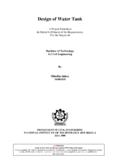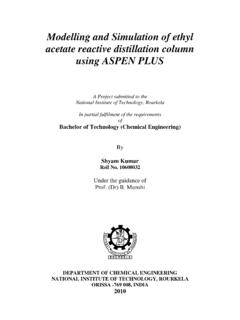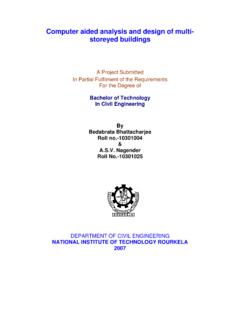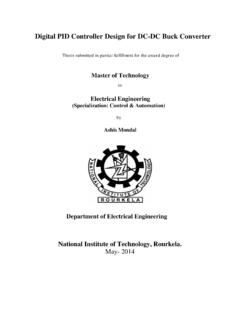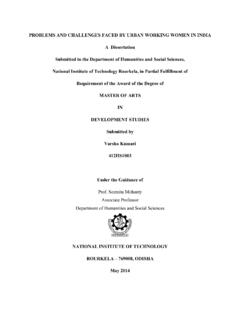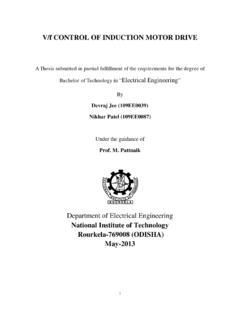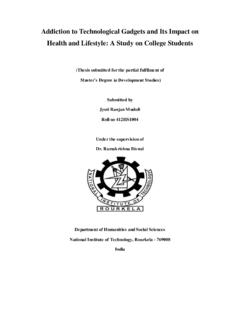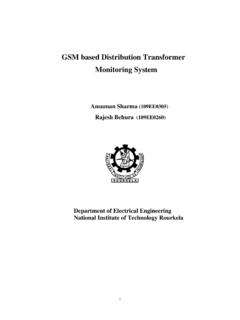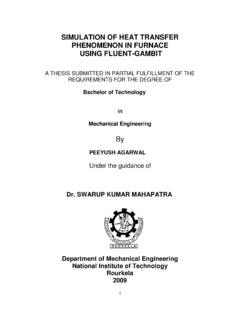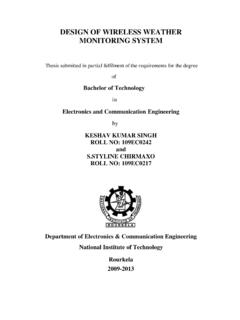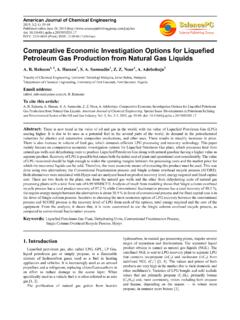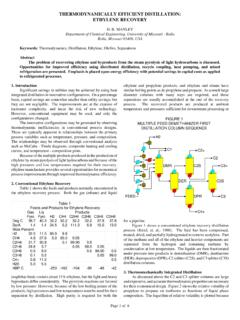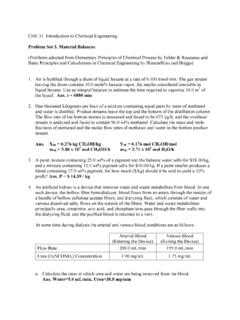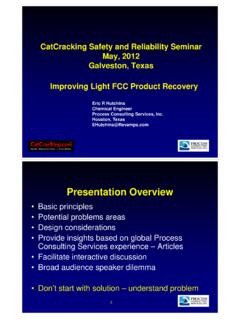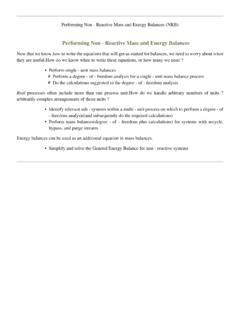Transcription of Simulation analysis of a Propane Recovery Plant using ...
1 I thesis on Simulation analysis of a Propane Recovery Plant using ASPEN PLUS In partial fulfilment of requirements for the degree of Bachelor of Technology (Chemical Engineering) Submitted by SANJANA ANAND CHOUDHARY 111CH0455 Under the supervision of Prof. (Dr.) Arvind Kumar Department of Chemical Engineering National Institute of Technology, Rourkela- 769008 ii NATIONAL INSTITUE OF TECHNOLOGY, ROURKELA CERTIFICATE This is to certify that the thesis entitled Simulation analysis of a Propane Recovery Plant from using ASPEN PLUS , submitted by Sanjana Anand Choudhary (111CH0455), to National Institute of Technology Rourkela is a bonafide report of the research work carried out by her, in the Department of Chemical Engineering, National Institute of Technology, Rourkela under my supervision. The thesis submitted is worthy of consideration for the partial fulfilment of award of the degree of Bachelor of Technology in accordance with the regulations of this Institute.
2 The results incarnated in the report are authentic to the best of my knowledge Prof. (Dr.) Arvind Kumar DATE: Supervisor Department of Chemical Engineering NATIONAL INSTITUE OF TECHNOLOGY, ROURKELA-769008 iii ACKNOWLEDGEMENT I would like to convey my immense gratitude to my supervisor, Prof. (Dr.) A. Kumar, Department of Chemical Engineering, National Institute of Technology Rourkela in guiding me through this research work. The technical discussions with Prof. , his never ending support, motivation and valuable knowledge helped me to build my research skills. I also thank Prof. (Dr.) P. Rath, Head of the Department of Chemical Engineering for allowing me to use the departmental resources whenever sought for. I extend my sincere thanks to other faculty members for their contribution in this work. In the end, I am indebted to my family members and friends for their highest degree of support and constant encouragement.
3 SANJANA ANAND CHOUDHARY 111CH0455 iv ABSTRACT Natural gas is a good source of various hydrocarbon compounds, but, alkanes with three or more number of carbon atoms in there chain are of greater value as fuels as well as pure components. A cryogenic Plant is setup to recover Propane , butane, and other heavier alkanes with two operating distillation columns ; de-methanizer and de-ethanizer. The available software Aspen Plus is used to simulate this cryogenic Plant to serve the purpose of Recovery .This software facilitates us to infer the impact of the operating variables on the efficiency of the Plant . The use of cryogenic plants for this purpose is a latest project carried on just by a few companies, so the idea here is to analyse the operating variables to optimize the Recovery . Keywords: turbo-expander; gas sub-cooled process; cryogenic Plant ; v CONTENTS TOPIC PAGE NO.
4 COVER PAGE i CERTIFICATE ii ACKNOWLEDGEMENT iii ABSTRACT iv CONTENTS v LIST OF FIGURES vii LIST OF TABLES ix Overview 1 1. INTRODUCTION AND LITERATURE SURVEY 2-7 NATURAL GAS 2 Propane PLUS Recovery 2 CRYOGENIC Plant PROCESS 3 CRYOGENIC PROCESSING GAS TECHNOLOGIES 4 DUAL COLUMN Propane PLUS Recovery 6 PREVIOUS WORKS 7 ASPEN PLUS 7 2. PREREQUISITE INPUT AND FLOW SHEET MODELING 8-14 vi NATURAL GAS COMPOSITION 8 PROCESS FLOWSHEET 9 columns AND EQUIPMENT 9 PREREQUISITE DATA 9 DESCRIPTION OF PROCESS 11 CHALLENGES 11 ASPEN PLUS FLOW SHEET 13 3. Simulation RESULTS AND DISCUSSIONS 15-23 STREAM RESULTS 15 Plant PERFORMANCE analysis 16 Effect of Split fraction S2 17 Effect of Temperature of V1 19 Effect of Column Pressure 21 4. CONCLUSIONS 24 REFERENCES 25 vii LIST OF FIGURES FIGURE NO. TITLE PAGE NO. CHAPTER-1 1 Figure Absorption Plant (Advanced Extraction Technologies, Inc) 4 2 Figure GSP Process (Ortloff Engineers ltd.)
5 5 3 Figure SCORE Process (Ortloff Engineers ltd.) 6 4 Figure DCP Cryomax (TECHNIP Licensors) 7 CHAPTER-2 5 Figure ASPEN PLUS Flow Sheet for the study 14 CHAPTER-3 6 Figure Propane Recovery vs Split fraction of S2 17 7 Figure BHP C003 vs Split fraction of S2 18 8 Figure Heat Duty of E-001vs Split fraction of S2 18 9 Figure Heat Duty of E-003vs Split fraction of S2 18 10 Figure Heat Duty of E-005vs Split fraction of S2 19 11 Figure Propane Recovery vs V1 temperature 19 12 Figure BHP C003 vs V1 temperature 20 13 Figure Heat Duty of E-001 vs V1 temperature 20 14 Figure Heat Duty of E-003 vs V1 temperature 20 15 Figure Heat Duty of E-005 vs V1 temperature 21 viii 16 Figure Propane Recovery vs Column Pressure 22 17 Figure BHP C003 vs Column Pressure 22 18 Figure Heat Duty of E-001vs Column Pressure 22 19 Figure Heat Duty of E-003vs Column Pressure 23 20 Figure Heat Duty of E-005vs Column Pressure 23 ix LIST OF TABLES TABLE NO.
6 TITLE PAGE NO. CHAPTER-2 1 Natural gas composition ( Cawthorne Channel) 9 2 Table Natural gas composition 9 3 Table Specified Data for Distillation Column ( D. Fissore et al) 10 4 Table Specified Parameters of Exchangers ( D. Fissore et al) 11 5 Table Specified Parameters of Compressors ( D. Fissore et al) 11 6 Assumed data for other equipment of the Plant 12 CHAPTER-3 7 Table Feed- Product Stream Results 15 8 Table Output of considered parameters 17 1 OVERVIEW OF THE PROJECT Ever since the recognition of natural gas being used as a desirable fuel, the prerequisite for its transportation to industries has led to the enforcement of treating and processing technologies. All over the world, the gas processing market meets a wide variety of economic challenges. These may be for merely fulfilling a gas conveyance arrangements to acquiring merely high ethane Recovery for providing feed to other plants. Similar to gas usage, local industries for natural gas liquids (NGL), and infrastructure vary, the contaminants and inlet conditions of the natural gas to be processed may vary, too.
7 Every undergoing project must meet specific norms for cost-effectiveness depending on the markets for gas and NGL products and the combination of characteristics of the available gas. The NGL Recovery generally falls in following three parts: ethane-plus Recovery , Propane -plus Recovery , and flexible ethane rejection or Recovery . Propane is a by-product of domestic natural gas processing, or by production from crude oil refinement. Due to the advantages of Propane , of being a cleaner fuel which can be used for almost all purposes, that is from running vehicles to household activities, it has been on a rising demand. Nearby, 48 million of population in the use Propane on a daily basis. Various Propane Recovery plants have been set up in the last decade to provide the world with a source of cleaner energy. Objective of this work is to provide an analysis of a Propane plus Recovery Plant from natural gas.
8 Analysing different methods and their outputs, giving review for the most suitable methods. Carrying the Simulation of this process, and checking its dependence on various operating parameters, the optimum conditions are found using ASPEN plus software. 2 CHAPTER 1 INTRODUCTION AND LITERATURE SURVEY Natural gas Natural gas is formed after the decomposition of dead plants and animals that have been deposited centuries ago beneath the rocks due to some natural calamities. These submerged beds are also a rich source of various other hydrocarbons, coal and petroleum. Natural gas contains organic as well as inorganic compounds. Cleaner than petrol and diesel, it is the cheapest form of fuel that is available to the humankind. In vehicles it is used in compressed form as CNG; used for household purposes, aviation, generation of power, transportation, production of hydrogen and other hydrocarbons. Inlet gas properties including its pressure, degree of water saturation, heavier liquid content, and other contaminants can affect the selection of the appropriate technology to treat gases.
9 Production objectives such as liquid and gas product specifications, liquid Recovery percentages, and type of liquid products to be also produced have significant impact. Propane Recovery Natural gas has a maximum composition of methane (89%), and considerable ethane (6-7%). Hence, the rejection of methane and ethane from the natural gas would serve the purpose of Propane plus Recovery . This is done by employing gas processing plants which are, Absorption plants and Cryogenic plants. As the names suggest, cryogenic plants involve refrigeration; absorption plants requires action of absorbent on the gas. These plants have different efficiencies, advantages and disadvantages which are discussed in the following section. 3 Cryogenic Plant Process In an absorption Plant as shown in figure , two towers are employed. They use an oil absorbent. The first tower is used for absorption of Propane plus components in the oil absorbent and thereby recovered, while the second is used for the regeneration of the absorbent to get bottom product as lean solvent and top product as the required Propane plus components.
10 This is a continuous process, hence, we have a recycle stream containing lean solvent, to the first tower. This Plant can get a Recovery of 70-90%. Most of the part of the capital is spent on equipment and still for oil absorber Plant . Cryogenic plants work by refrigerating the gases, liquefying almost all Propane and other heavier hydrocarbons. A series of fractionating columns can be used to separate the liquids according to the requirement. They have less process equipment and more mechanical pressure changers. The Recovery is in the range of 90-98%. Hence, more profitability is ensured in the cryogenic process Plant set up as it gives better Recovery and is cheaper than latter. The cryogenic methods Figure : Absorption Plant (ADVANCED EXTRACTION TECHNOLOGIES, INC) 4 employing turbo-expanders were introduced mainly for ethane Recovery , the residue-reflux systems improves this system to avail Propane -plus Recovery in the two tower systems, such developments add to the original GSP process.
